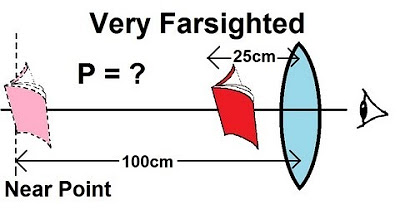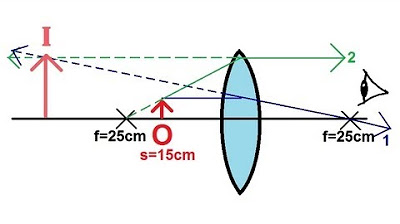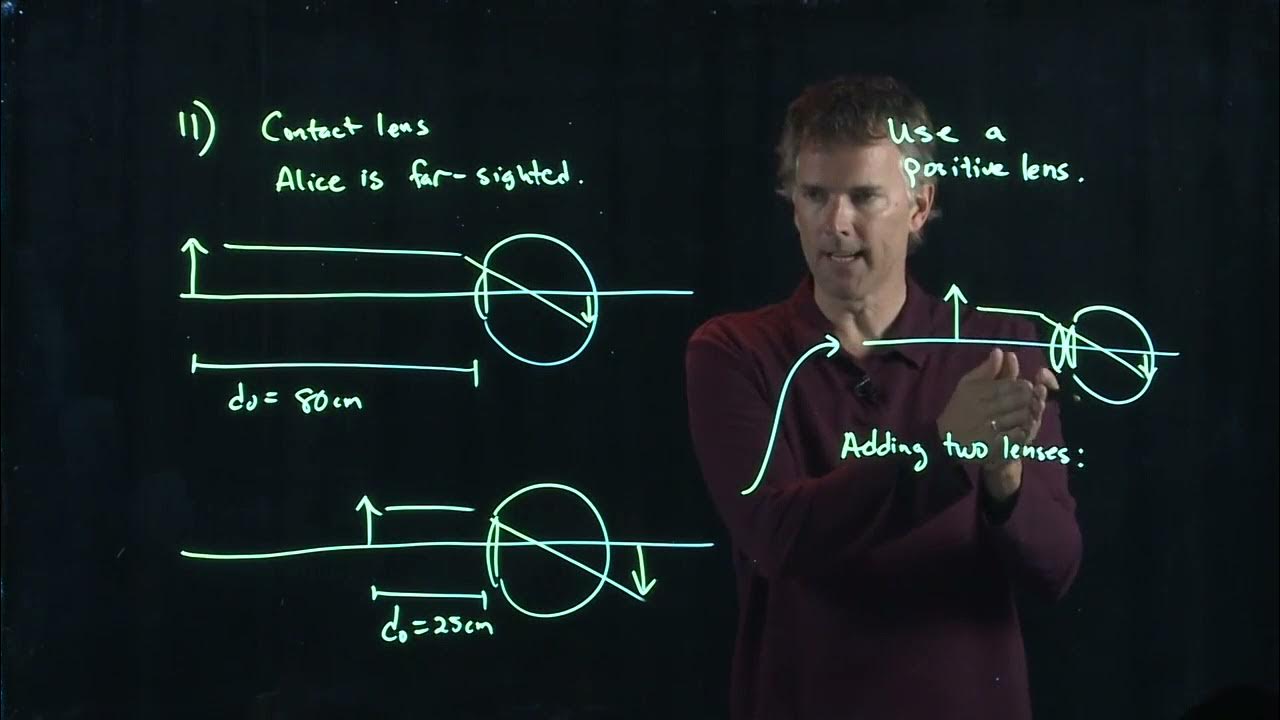Physics - Optics: Vision Correction (2 of 5) Nearsighted
TLDRThis educational video script explains the concept of vision correction for nearsightedness using corrective lenses. It introduces the 'Far Point', the farthest distance at which a nearsighted person can see clearly, and demonstrates how to calculate the required focal length of a diverging lens using the lens equation. The script then converts this measurement into the power of the lens in diopters, which is the standard unit used for prescription glasses. The example provided illustrates how to correct vision for an individual with a Far Point at 50 cm, highlighting the practical application of optical principles in everyday life.
Takeaways
- 👓 The video is about correcting vision for nearsightedness and farsightedness using corrective lenses.
- 🎯 Nearsightedness is characterized by a far point where objects beyond this distance appear out of focus.
- 📏 The far point in the example is 50 cm, which is the farthest distance at which the person can see clearly.
- 🔍 The goal is to correct vision so that distant objects appear as if they are at the far point.
- 🌐 The lens equation ( 1/f = 1/s + 1/s' ) is used to find the focal length of the corrective lens.
- ∞ For distant objects, the object distance ( s ) can be approximated as infinity.
- 🔄 The image distance ( s' ) is negative because the image is virtual, which means it appears in front of the lens.
- 📐 The focal length ( f ) is calculated to be -50 cm for the lens to correct the vision for the given far point.
- 🔢 The power of the lens is the reciprocal of the focal length in meters, resulting in -2 diopters for this case.
- 🛒 To correct nearsightedness, one can purchase glasses with a power of -2 diopters, which will help see distant objects clearly.
- 🔄 The script also mentions that further examples will be provided to correct vision for different far points and for farsightedness.
Q & A
What is the Far Point for a nearsighted person as described in the video?
-The Far Point is the farthest point at which a person can see things clearly. In this case, it is 50 cm.
What type of lens is used for correcting nearsightedness?
-A diverging lens is used for correcting nearsightedness.
Why is an object at Infinity considered in the lens equation?
-An object at Infinity is considered because it simplifies the calculations and represents objects that are very far away.
What is the lens equation used in the video?
-The lens equation used is 1/f = 1/s + 1/s', where f is the focal length, s is the object distance, and s' is the image distance.
How is the image distance (s') described in the context of nearsighted correction?
-The image distance (s') is 50 cm and is negative because the image is a virtual image formed in front of the lens.
What is the focal length (f) of the corrective lens needed for a person with a Far Point of 50 cm?
-The focal length (f) of the corrective lens is -50 cm.
How is the focal length converted to meters?
-The focal length is converted to meters by dividing by 100, resulting in -0.5 meters.
What is the power of the lens in diopters for a focal length of -0.5 meters?
-The power of the lens is -2 diopters.
Where can one find glasses with the required power for nearsighted correction?
-Glasses with the required power can be found at stores like Walmart or any drugstore.
What will be the result of wearing glasses with a power of -2 diopters for someone with a Far Point of 50 cm?
-Wearing glasses with a power of -2 diopters will allow the person to see objects clearly that are far away.
Outlines
👓 Understanding Nearsightedness and Corrective Lenses
This paragraph introduces the concept of nearsightedness, also known as myopia, and explains the process of vision correction for those with this condition. The speaker describes a nearsighted person whose farthest point of clear vision, or 'Far Point', is 50 cm away. To correct this, they discuss using corrective glasses with a diverging lens to adjust the focus of distant objects, effectively bringing their image within the person's Far Point. The explanation involves the lens equation, which is used to calculate the required focal length of the corrective lens. The calculation shows that a lens with a focal length of -50 cm, or -2 diopters in power, would be needed for this individual. The paragraph concludes with advice on how to select the appropriate corrective lenses based on the calculated power.
Mindmap
Keywords
💡Nearsighted
💡Far Point
💡Diverging Lens
💡Virtual Image
💡Lens Equation
💡Focal Length
💡Infinity
💡Diopters
💡Corrective Vision Glasses
💡Power of the Lens
Highlights
Introduction to online lecture on vision correction techniques for nearsightedness and farsightedness.
Explanation of nearsightedness and the concept of the Far Point being 50 cm away for the example person.
Objective to correct vision by using corrective lenses with a diverging lens to bring the image inside the Far Point.
Introduction of the lens equation and its application in finding the focal length for corrective vision glasses.
Use of the lens equation with the object at 'infinity' to simplify calculations for nearsighted vision correction.
Calculation of the image distance as a negative value due to the virtual image formed by the diverging lens.
Derivation of the focal length of the corrective lens using the lens equation and given parameters.
Conversion of the focal length from centimeters to meters for standard unit of length in lens power calculation.
Calculation of the lens power in diopters for nearsighted vision correction.
Practical advice on selecting corrective lenses based on lens power for nearsighted individuals.
Discussion on the virtual images seen by nearsighted individuals when wearing corrective lenses.
Introduction to the process of vision correction for farsighted individuals as the next topic.
Explanation of the importance of the Far Point in determining the type of vision correction needed.
Highlight of the practical applications of the lens equation in everyday vision correction.
Clarification on how to communicate lens requirements to optical stores for vision correction.
Emphasis on the use of diopters as the standard unit for lens power in vision correction.
Anticipation of further examples and discussions on vision correction for different Far Point distances.
Transcripts
Browse More Related Video

Physics - Optics: Vision Correction (4 of 5) Farsighted

Physics - Optics: Vision Correction (5 of 5) Very Farsighted

Near Point and Far Point | Physics with Professor Matt Anderson | M28-06

Physics - Optics: Vision Correction (1 of 5) Introduction

Physics - Optics: Lenses (4 of 4) Converging Lens

Contact Lenses | Physics with Professor Matt Anderson | M28-21
5.0 / 5 (0 votes)
Thanks for rating: